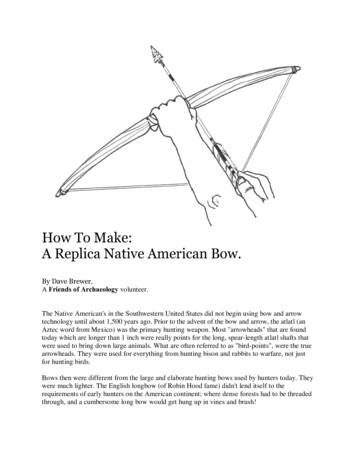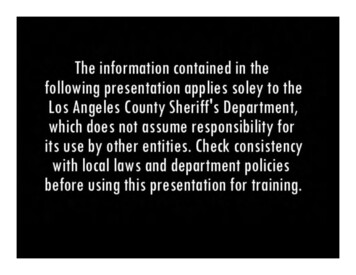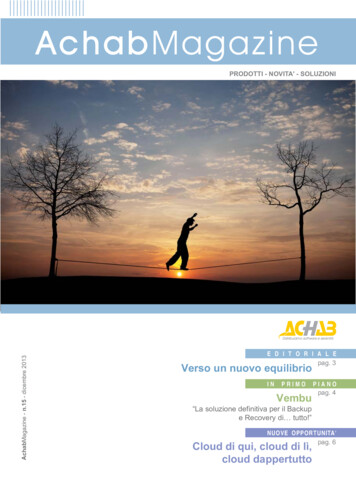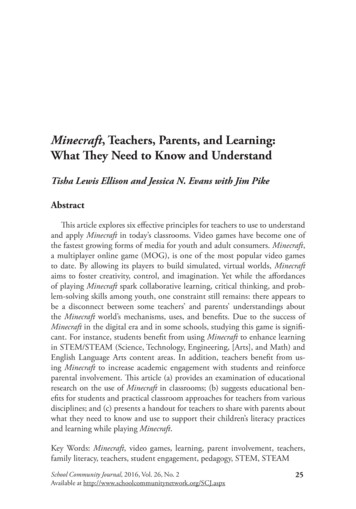
Transcription
How To Make:A Replica Native American Bow.By Dave Brewer,A Friends of Archaeology volunteer.The Native American's in the Southwestern United States did not begin using bow and arrowtechnology until about 1,500 years ago. Prior to the advent of the bow and arrow, the atlatl (anAztec word from Mexico) was the primary hunting weapon. Most "arrowheads" that are foundtoday which are longer than 1 inch were really points for the long, spear-length atlatl shafts thatwere used to bring down large animals. What are often referred to as "bird-points", were the truearrowheads. They were used for everything from hunting bison and rabbits to warfare, not justfor hunting birds.Bows then were different from the large and elaborate hunting bows used by hunters today. Theywere much lighter. The English longbow (of Robin Hood fame) didn't lend itself to therequirements of early hunters on the American continent; where dense forests had to be threadedthrough, and a cumbersome long bow would get hung up in vines and brush!
So a short, stout bow was used pretty much by all tribes. While it didn't shoot as far as a longbow, that was not the idea. American hunters relied on stealth, tracking skills, and patience to getclose to their quarry in order to shoot an accurate lethal shot.In order to accomplish this, the hunter (or hunters, if a hunting party was assembled for huntinglarge game), would set up a blind (a rocky wall or brush construction behind which to hide) andwait near a creek, spring, or river where animals were known to drink on a daily basis. As theanimals came by, the hunter would shoot at them. Before the bow, the hunter would have to riseup with his arm extended to throw the spear, making it much more likely that he would startlethe animal before getting off a throw.If the animal wasn't killed, but only wounded, the hunter would track the animal until he couldkill it. Tradition taught these hunters to offer thanks to the slain animal's spirit for providing foodfor his family. When an animal allowed itself to be killed, it was a gift, and the hunter needed toacknowledge that gift.Weapons and hunting gear were a man’s means of livelihood and a source of pride. A young boywould practice with the bow and arrows made for him by his uncles. As his skills improved, sodid his equipment. Girls and women could hunt with bows and arrows as well, but hunting wasmore traditionally a role for men.2
A child’s practice with a small bow and arrows was no small thing. In perfecting hunting skillshe could bring down rabbits and squirrels and other small game. They were welcome additions tothe cooking pot, contributing to the family’s well being.SAFETY TIP NUMBER ONE: A bow turns an arrow into a deadly weapon. If an arrow hitssomething, either intentionally or accidentally, it will cause damage, harm, and even death. Thesame rules apply to arrows as would apply to a gun. Use your bow and arrow only with adultsupervision. Aim only at targets, not people or animals. Make sure that nothing is behind thetarget that could be hurt if you miss. Practice for safety as well as for improving your skill withthe bow.SAFETY TIP NUMBER TWO: "Making a Bow" is recommended for children only with adultsupervision, both in making and using the bow. Shaping of the bow is accomplished by whittlingwith a knife, or using a drawknife, and it is ironic that a sharp edge can be safer than a dull edge.A dull knife requires more force to cut the wood and can behave unpredictably as a result. Asharp knife allows the whittler to remove small amounts of wood at a time with only a smallamount of well-controlled force. Always cut away from your body, never use the knife in a waythat someone else might be cut if you slip, and if you find yourself applying a lot of force, stopand rethink what you are doing. Never use a folding knife that doesn’t have a secure lock to keepthe blade open!3
Even a relatively short bow (3 to 5 feet) is capable of shooting an arrow quite a distance. Thepower of a bow isn’t only in its length, however, but its power is really in its stiffness. After anarcher learns the basic skills with a light bow, they can make a longer and stiffer bow forshooting targets at greater distances. There is a little lesson in physics at the end of this “How to”guide.Native Americans used all kinds of wood for bows, but some wood is better than others for thefinest bows. Bows were usually made with the best wood that was locally available in theirterritory, but some woods had such a good reputation for bows that people would trade bowwood over hundreds of miles. One such wood is Osage Orange, from the Ozark Mountains.Osage orange is a hardwood that becomes bright orange in color when its bark is peeled, and it isstiff and strong. Ash, oak, yew, hickory, elm, black locust, juniper and other local woods can beused for bows, although they may be more fragile.The selection of the right piece of wood helps in the creation of the bow, including length,straightness, and grain (lack of side branches). Bow makers debate whether it is best to make abow out of seasoned (dry) wood or fresh (green) wood. Dry wood can be harder to whittle butthere is less chance you will be unhappily surprised by splitting after the bow is made. Greenwood is more readily available, it’s a little easier to whittle, but the finished bow may split andbecome fragile as it dries.4
Look for a shoot or limb that is nearly straight for 3 to 5 feet in length and is about 1 to 1½inches in diameter. REMEMBER to ask permission before cutting wood on another person'sproperty. You may find that this is the hardest part about making a bow. Side twigs are ok, butside branches are not since they distort the grain of the limb. In some cases, you can cut a thickerlimb with side branches if all of the side branches are one side of the limb. The thick limb can besplit down the middle (by an adult, using an axe or wedge), and the side without the branches canbe used for a bow.The piece of wood that you cut probably will be thicker at one end than at the other. Begin at thethinner end, trimming off side twigs and whittling off the bark. Don’t cut into the wood verydeeply, because any notches into the wood will create weak spots, which in turn can cause thebow to break Something you do not want to happen. When the bark and twigs are removedfor the entire length of the limb, you have a blank or “bow staff.”Locate the center of the bow staff, and allow a six-inch space for the handgrip (this will be thethickest part of the finished bow). The thinner end of the bow staff should be shaped (whittled)first because there is less wood to remove and it will serve as the "model" for the reduction ofwood in the thicker end of the staff.The thickness of each bow end should taper smoothly and continuously from the handgrip tothe tip, but the tip needs to be thick enough to hold a notch for the bow string without breaking.A typical thickness will be ¾ to 1 inch at the handgrip to ¼ inch at the tip. The cross sectionthrough the bow end should be more and more like a flattened oval as you move away from therounded oval of the handgrip.5
Once both ends have been whittled into their tapers, notches can be cut to hold the bowstring.The bowstring will be attached (tied) permanently to one end, while the other end should havenotches whittled so that the bowstring loop can be slipped on and off. This means that the notchmust hold the loop securely in place while the bow is bent for use and the string is tight.When the bow isn’t in use, the bow should be bent and the loop should be slipped off the notchso the bow can be stored in a “relaxed” position. Once the notches are designed and cut, the endsand handgrip can be sanded smooth.The real art to making a bow is in designing the tapers and thickness so that the bow is bothstrong and flexible. The bow needs to bend without breaking when the arrow is pulled back to itsfull length, but it needs to be stiff enough that the bow string delivers a lot of force to the arrowwhen the arrow is released and the bow snaps back to it’s “ready” position. If the bow is too stiff,the arrow can’t be shot with accuracy, or if you pull a stiff bow with all your strength, you canactually break the bow and you will have to start over. If the bow is too flexible (light), there willbe little power behind the arrow. For beginning archers, it's best to start with a light flexible bow,even if the arrow doesn’t shoot very far. They can graduate to a stiffer bow once their skillimproves.Once the ends have been shaped and the notches are ready, all you need is a bowstring.The bowstring can be made from heavy hemp twine, heavy monofilament fishing line, rawhide,or animal sinew. The bowstring can be a single strand, or more commonly it is made by spinningor braiding multiple thin strands together. The string needs to be thick enough not to break whenthe arrow is pulled to its limit, and it needs to be thin enough to fit into the nock of the arrow.Animal sinew and yucca string were used in the past. The animal sinew came from the tendonsof deer and elk. It was a superior material for bowstrings although it would stretch to the point of6
becoming worthless if it got too wet. You can purchase imitation sinew from craft stores thatworks well. It consists of nylon “dental tape” that has been impregnated with a yellow-brownwax. It comes in spools and can be braided into strong and long-lasting bowstrings. The easiestbraids are made with three strands.Alternate placing each outer strand between the other two.Try to maintain an even “tightness” to the braid for its entire length, which should be at least 12inches longer than the bow to give you enough room to make the loops.Make a loop in one end of the bowstring that fits tightly in the notches of one end of the bow.This will be the “permanent” end of the bowstring.Make a loop in the other end of the bowstring that is positioned so that the bow will be bentslightly when the loop is resting securely in the second notch. The tension is needed to keep thebowstring in place and to make sure that the bow and bowstring are ready when needed. You7
will need to bend the bow carefully in order to slip the loop over the end. It helps to use your footand knee to brace the bow while you bend it.As strange as it sounds, the average person who tries to shoot an arrow with a bow for the firsttime is usually frustrated. We see arrows shot in the movies all the time, and yet never do we seethe "up close" operation itself! First (if you are right handed), grip the bow in the center of itslength with your left hand (reverse these directions if you are left handed).8
Next, place the arrow so it rests on the top of your handgrip, held against the bow with your righthand. Make sure that (of the three feathers) one feather always is positioned facing away fromthe bow.Grasp the arrow as shown in the drawings below. Either grip is fine. You then pull the bowstringback slowly to the length of the arrow, “feeling the bow” to make sure that it isn’t stressed to thebreaking point. Aim at the target, and let go of the arrow. A bit of practice will have youshooting arrows like a professional archer!9
If the bow feels like it might break, it is too stiff for the length of the arrow or you have chosenweak wood. The long term solution is to modify the bow or make a new one. The short termsolution is to not draw the arrow back to its full length or to use shorter arrows. Thinning thebow ends can make a bow more flexible, but you may have to thin the grip as well so that therearen’t abrupt changes in diameter that can weaken the bow.When the bow is not in use, the bowstring should be un-strung to save the bow from fatigue. Thebow will hold its strength a lot longer. Also, as the wood of the bow dries out, the wood canbecome fragile and subject to breakage if pulled too far. Native Americans would rub their bowswith animal fat to keep them from drying out. You can do the same with any lanolin based handcream. Do this at least once a month.When you have a bow that works, you can personalize it. You can add leather wrapping to thegrip area. This can be done by either wrapping a leather lacing (as in boot lacing) and secure itwith glue, or get a piece of scrap leather from either a hobby shop, a hide dealer or a shoe repair.Attach it in the manner of the lacing. You may need to secure the leather to the bow with awrapping of string over the leather until the glue dries.Bows can be decorated with paint or felt-tip markers. Designs can be carved in, but be carefulnot to weaken the bow or it may break at your design.Now we are done!But, we can enjoy a little physics lesson The bow conveys power to the arrow through the bowstring. The amount of power is equal to thestrength required to bend the bow into an arc when the arrow is drawn to its full length. If thebow is stiff (and if it doesn’t break), the amount of force can be great. Bows are described interms of “pounds of pull” necessary to bend the bow to the full length of the arrow. A “20pound” bow is lighter than a “40 pound” bow, and the heavier bow will shoot an arrow faster andover a much longer distance.The underlying equation that describes the flight of an arrow is:“F MA” or force equals mass times acceleration.The force (F) is a constant for each bow, reflecting its stiffness and the length of pull appropriatefor a particular length of arrow. Since F is constant, if M increases, A must decrease. If you havea heavy (solid-shaft) arrow, the mass (M) is relatively great, and the acceleration (A) imparted bythe bowstring will be less than if you have a light (cane) arrow. (See How to make an arrow forthe differences in the two types of arrows.). With the same bow (and as long as the arrows arethe same length), a cane arrow will fly faster and farther than a solid arrow. However, when thearrow hits its target, both arrows will impact with the same force, which is determined by thequality of the bow. If a hunter’s arrows are bouncing off of the target rather than penetrating, it’s10
because the bow is too light rather than because the arrows are “dull.” When a hunter has a“good bow,” he selects a heavy or light arrow depending on how close he can get to the preywithout scaring it away. Solid arrows are best for short distances, cane arrows are best for longdistances.Education Outreach ProgramFriends of ArchaeologyOffice of Archaeological Studieswww.nmarchaeology.org11
Weapons and hunting gear were a man ˇs means of livelihood and a source of pride. A young boy would practice with the bow and arrows made for him by his uncles. As his skills improved, so did his equipment. Girls and women could hunt with bows and arrows as










